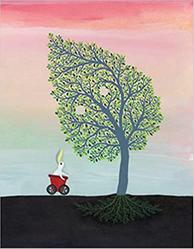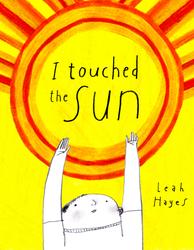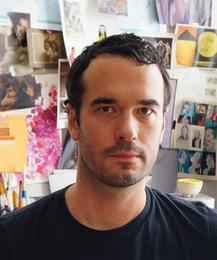
|

|
Leah Hayes is an illustrator and graphic novelist (Not Funny Ha-Ha). Her editorial illustrations appear in the New Yorker, New York Times, and other publications. I Touched the Sun (Enchanted Lion Books) is her first picture book. She lives in Massachusetts with her family.
Balint Zsako was born in Budapest, Hungary, to a textile artist mother and a sculptor father. His family immigrated to Canada when he was 10 years old. For the last 20 years, he has been exhibiting painting and collage, and his illustrations have appeared in the New Yorker, Harper's, and the New York Times Magazine. Bunny & Tree (Enchanted Lion Books) is Balint's literary debut. He lives in Los Angeles with his family.
Here, Hayes and Zsako discuss the differences between creating art, graphic novels, and books for children, and how great art can be created by accident and enhanced by imperfections.
Hayes: What were your artistic beginnings?
Zsako: Both of my parents are artists, and we left Eastern Europe before the Berlin Wall came down. I had a pleasant suburban childhood in Canada. I was a good student, so my parents, knowing how difficult a life in art can be, hoped I would do something else.
I went to school for photography but was also drawing the whole time. Straight out of college, I was selling my work through galleries. I also did a bit of editorial illustration and enjoyed it because it's a different way of thinking: here's a communications challenge, can you solve it for us? Whereas with fine art, it's more important to set up a good problem: I don't have to tell you what the answer is, you bring your own experience to the work.

|
|
| Leah Hayes | |
Hayes: My parents were both artists as well, and I went to Parsons for illustration. I loved what you were describing: the problem-solving aspect of illustration.
I started getting work while I was still in college. I wanted to start working so badly that I was going to the New York Times offices and knocking on their door with my portfolio. I was always into graphic novels--I wrote my first one and sent it to Fantagraphics. They published it right as I was leaving school.
Later, I started teaching at Parsons, even though I didn't graduate!
 |
|
| Balint Zsako (photo: Natalie Matutschovsky) |
|
Zsako: Can you share a bit about your book?
Hayes: I Touched the Sun is about a boy who finds his light. When he wants to fly up to the sun, everyone around him says he can't. But he closes his eyes and flies up anyway, eventually touching the sun, who shows him how to find his own inner warmth and bring it back home.
And how would you describe Bunny & Tree?
Zsako: Briefly, it's a wordless, 184-page picture book about a bunny and a shape-shifting tree going on an adventure and discovering friendship, transformation, and love.
Hayes: How did the idea for the book initially come about?
Zsako: I was reading stories to my three-year-old son, and three questions popped up. Can you tell a sophisticated story without written words? Can you convey emotions using only body language and color palette in place of facial expressions? And what would it look like to make an epic for young readers?
How about you?
Hayes: The idea for this book is inseparable from becoming a parent--it is for my son, about my son. He says, when he's reading it, "Oh, that's me!" without me even telling him.
The message was really that I want him to believe in himself, and in a world of "no's," to believe in his "yes." And if people tell him not to do something, to try it anyway.
Zsako: How did you arrive at the visual style of your book?
Hayes: It ultimately came about by accident. I work in black and white with pencil, but I love color. I also have different styles: a kind of cartoony style that I've done my whole life, and the ability to draw realistically, too. I always used to separate those: I'd draw realistically for certain jobs and do graphic novels in a cartoony way. But in I Touched the Sun, the boy in the book is simply drawn, whereas the other figures are more rendered.
Zsako: That's such a sweet mirroring of how life goes.
Hayes: I was always influenced by Charlie Brown, where the adults aren't drawn, they're just sounds. I thought that if there were adults in this book, they should look less relatable to the child.
I never thought I would be creating children's books, although I've been obsessed with children's books my whole life. And I don't know about you, but making this book was more challenging than anything I've ever done artistically. It was so intense, in terms of getting it right and caring about the message, and the artwork too.
Zsako: It's all those things, and it's also about how to be clean, clear, and economical. And it's so different from fine arts because of the collaborative revision process.
Hayes: How did your book change from start to finish?
Zsako: Before I brought the book to Enchanted Lion, it was half the length, and the ending was completely different. Many people looked at Bunny & Tree, and the general consensus was: "It looks really beautiful, but we don't know what to do with it." At the time, I thought it was done. But then of course, I worked with the team at ELB. I pushed back on a few things, but I appreciated that they identified big and small flaws. They mostly didn't tell me how to fix a narrative or stylistic problem; they just pointed it out and asked what I would do to address it.
Originally there were no double-page spreads, it was all single images on the right side. But this led to a monotonous rhythm and didn't serve the adventurous nature of the story. There were also happy discoveries in collaborative editing, like using the page turn to emphasize Tree's transformation. You stumble onto something that works, and then you go back and tease that out in other parts of the book.
Would you like to make another children's book after the experience of making this one?
Hayes: Yes! Books for children can have darkness, conflict, and sadness along with all the wonderful things you're trying to impart. All my favorite children's books are technically for kids but make adults sob when they're reading them. I always thought if I was to do a children's book, I'd like to make one that feels a bit ageless. I was 40 when I wrote this, and had a whole career of trying to be an artist in the world, so I wanted to show everything I've learned in the form of this project.
Zsako: Similarly, I was about the same age when I was making the artwork for this book, and I tried to distill everything I knew about visual storytelling into it.
But interestingly enough, I found that I was compelled to leave in the traces of corrections in the final artwork. These could have been easily removed, but I find meaning in flaws: the book is alive, it has previous incarnations, and there is a generosity in not being airtight.

